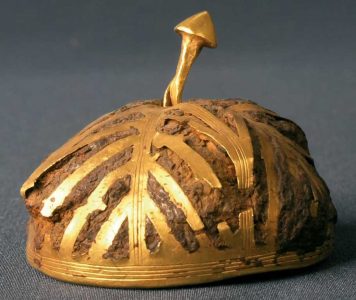 Analysis of two iron objects in the Treasure of Villena, the Bronze Age gold hoard discovered in southeastern Spain in 1963, have identified the metal as meteorite iron. The treasure is the largest and most important Bronze Age hoard ever found in the Iberian Peninsula, and the second largest set of prehistoric goldsmithing in Europe after the riches found in the Royal Tombs of Mycenae, Greece. Now we know it is also the only hoard on the Iberian Peninsula to contain objects made from meteoric iron.
Analysis of two iron objects in the Treasure of Villena, the Bronze Age gold hoard discovered in southeastern Spain in 1963, have identified the metal as meteorite iron. The treasure is the largest and most important Bronze Age hoard ever found in the Iberian Peninsula, and the second largest set of prehistoric goldsmithing in Europe after the riches found in the Royal Tombs of Mycenae, Greece. Now we know it is also the only hoard on the Iberian Peninsula to contain objects made from meteoric iron.
The first pieces of the treasure were found loose in a gravel pit on December 1, 1963. Workers found a gold bracelet and took it to a jewelry store where they were informed it was enormously valuable by weight alone, never mind its historic significance. Archaeologist José María Soler heard about the find and quickly followed up with an excavation of the pit. Soler and local volunteers unearthed the rest of the treasure grouped together in a large ceramic vessel.
The hoard consists of 66 pieces, most of them gold, nine of them 23.5 carat gold. The 11 bowls, 28 bracelets, three bottles and miscellaneous fragments of decorative elements made of gold all together weigh 9.75 kilos (21.5 lb). There are also three bottles made of silver (600 grams, 1.3 lb, total weight), a gold and amber button and the two iron pieces that were the subject of the recent study.
Iron was extremely rare in Bronze Age Spain, and therefore considered a precious metal like gold and silver. The iron in the Villena hoard is the oldest in Spain. The objects are an open bracelet with rounded ends and a hollow hemisphere of iron covered with thin bands of gold incised with decorated lines that may have been a sword pommel. The corrosion of the iron over the centuries has broken and deformed some of the gold strips.
The discovery of the treasure caused a sensation at the time, and garnered enormous scholarly attention. Experts have long debated its date range. The metal analysis that revealed the meteorite iron also conclusively answered the dating question: the Villena Treasure dates to the Late Bronze Age (1,400-1,200 B.C.)
Their analysis has been able to determine that these are not pieces made with terrestrial iron produced by the reduction of minerals existing in the mantle of planet Earth. Instead, they are “extraterrestrial and were made during the Late Bronze Age.” To obtain this data, two tiny extractions were made, under the supervision of the technical staff of the Alicante museum. The samples were then taken to Madrid for analysis at the laboratory of the National Archaeological Museum.
“Meteorite iron is found in certain types of aerolites that, since they come from outer space, are composed of an iron-nickel alloy with a variable nickel composition greater than 5% by weight. They also contain other minor and trace chemical elements, cobalt being one of the most significant. However, the levels of nickel in terrestrial iron are generally low or very low and frequently not detectable in analysis,” the study explains.
The study has been published in the journal Trabajos de Prehistoria. The treasure, which has been on display at the Villena Museum since its discovery, will soon move to a new state-of-the-art facility. The new Villena Museum (MUVI), located in a restored 1909 flour mill, opens on May 17th with the Treasure front and center in a spacious 800-square-foot room.
